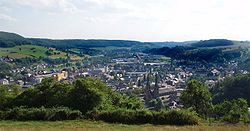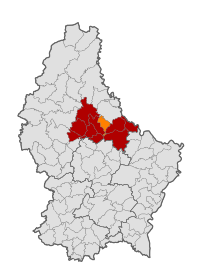Diekirch
Diekirch
Dikrech(Luxembourgish) | |
|---|---|
 | |
 Map of Luxembourg with Diekirch highlighted in orange, and the canton in dark red | |
| Coordinates:49°52′05″N6°09′24″E/ 49.8681°N 6.1567°E | |
| Country | |
| Canton | Diekirch |
| Area | |
| • Total | 12.42 km2(4.80 sq mi) |
| • Rank | 87thof 100 |
| Highest elevation | 396 m (1,299 ft) |
| • Rank | 54thof 100 |
| Lowest elevation | 187 m (614 ft) |
| • Rank | 20th of 100 |
| Population (2023) | |
| • Total | 7,295 |
| • Rank | 21stof 100 |
| • Density | 590/km2(1,500/sq mi) |
| • Rank | 15thof 100 |
| Time zone | UTC+1(CET) |
| • Summer (DST) | UTC+2(CEST) |
| LAU 2 | LU0000603 |
| Website | diekirch.lu |
Diekirch(French pronunciation:[dikiʁʃ];German pronunciation:[ˈdiːkɪʁç];Luxembourgish:Dikrech[ˈdikʀəɕ]or (locally)Dikrich[ˈdikʀiɕ];fromDiet-Kirch,i.e. "people's church" ) is acommunewithtown statusin north-easternLuxembourg,in thecanton of Diekirchand, until its abolition in 2015, thedistrict of Diekirch.The town is situated on the banks of theSauerriver.
The town's heraldic shield, showing a crowned lion on a castle, was granted in 1988. It is based on the town's 14th-century seal and arms.[1]
In 1977, Diekirch became the first town in Luxembourg to have apedestrian zone.
Diekirch is home to a brewery of national importance carrying the town's name.
Three secondary schools are located in Diekirch:Lycée classique de Diekirch,Lycée technique hôtelier Alexis HeckandNordstadlycée.[2]
The town is home to the national operational headquarters of theLuxembourgish Armyat the Haerebierg Military Centre (located on the hillHerrenberg) and theNational Museum of Military History,reflecting Diekirch's pivotal role in theBattle of the Bulge,a major battle ofWorld War II.It was here that the river Sauer was crossed on the night of January 18, 1945, by the US5th Infantry division.
The town is also the seat of one of the six regional headquarters of theGrand Ducal Policeand one of Luxembourg's two judicial districts.
History
[edit]The town received its name, according to old sources, whenCharlemagnein the late 8th century resettled Saxons, in order to bring them under his control. One of the centres of these settlements was in the area of Diekirch. In order to convert the pagan Saxons to Christianity, a church was built, which gave the settlement its name: "Diet-Kirch" ( "people's church" ). InOld Franconian,thioda(Old High German:"diota" – the people). Þeudō is a reconstructed word from Germanic, which plays a role in the etymology of the term "Deutsch".
In the 14th century,John,the blind king of Bohemia, fortified it, surrounding the place with acastellatedwall and a ditch supplied by a stream. It remained more or less fortified until the beginning of the 19th century when the French, during their occupation, levelled the old walls and substituted avenues of trees.[3]
In the course of extensive excavation in the 1960s, it was shown that the St. Laurence church is a Roman building. In the early 20th century, wall ruins and mosaics were found north of the town center. Archaeological investigations in 1992–1993, 1999, and 2008 enabled the reconstruction of a large Roman villa, which extended over all the land of the medieval town and was abandoned in the early 5th century.

Sport
[edit]Diekirch hosts the "International March of Diekirch", a 20 km up to 40 km road walking event. Held since 1968, it is open to both the military and civilians, with finishers earning the Medal of the "Marche de L’Armée", a Luxembourgish Army award. The marches of 2020 and 2021 were canceled due to the Coronavirus Pandemic, and held as a virtual event in 2022, with the distances walked in different locations across the world. The march drew significant interest from service members across NATO countries. This included the United States Army, with the 492nd Civil Affairs Battalion based out of Buckeye, Arizona hosting the largest individual marching event in the United States that year. In 2023 the march returned to being only held as a live event in Diekirch.[4][5][6]
Diekirch has an annualcross country runningcompetition — theEurocross— which is anIAAFpermit meeting and attracts world-class runners, withGabriela SzaboandIrina Mikitenkoamong past winners.[7]
Mascot
[edit]The town'smascotis thedonkey.There is a donkey fountain in the centre of Diekirch. The yearly cavalcade (carnival procession) is held under the sign of the donkey.
Population
[edit]Graphs are unavailable due to technical issues. There is more info onPhabricatorand onMediaWiki.org. |
Notable people
[edit]
- Paul Eyschen(1841–1915), a Luxembourgish politician, statesman, lawyer and diplomat. He was the 8thPrime Minister of Luxembourg,serving for 27 years, 1888–1915.
- Alphonse Munchen(1850–1917), a Luxembourgish engineer and politician;Mayor of Luxembourg Cityfrom 1904 to 1915.
- Joseph Bech(1887–1975), a Luxembourgish politician and lawyer. He was the 15thPrime Minister of Luxembourg,serving for 11 years, from 1926 to 1937.
- Henri Losch(1931–2021), a Luxembourgish actor, writer, and teacher.
- Ali Kaes(born 1955) a Luxembourgish politician, mayor ofTandel
- GeneralGaston Reinig(born 1956) a Luxembourgian soldier and a formerChief of Defenceof theLuxembourg Army
Sport
[edit]- Alfred Albert Joe de Re la Gardiur(1881–1941), a Professional wrestler.
- Léon Roth(born 1926) a Luxembourgian sprint canoer, competed in the1952 Summer Olympics
- Johnny Lucas(1931–1993) a Luxembourgian sprint canoer, competed in the1952 Summer Olympics
- Michael Pinto(born 1993) a Portuguese footballer, played over 250 games and 31 forLuxembourg
Twin towns — sister cities
[edit]Gallery
[edit]-
Diekirch city centre
-
The Old Church of St Lawrence was built on a Gallo Roman base
-
The Wirtgensschlass or Schloss Wirtgen is nowadays used as one building of the conservatory of music.
-
Detail of one of the donkey fountains in the city centre
-
Fountains in the municipal park
-
TheSauerriver flows through Diekirch.
References
[edit]- ^"Diekirch".ngw.nl.9 September 2022.
- ^"Nordstad-Lycée Diekirch NOSL".NOSL.
- ^One or more of the preceding sentences incorporates text from a publication now in thepublic domain:Chisholm, Hugh,ed. (1911). "Diekirch".Encyclopædia Britannica.Vol. 8 (11th ed.). Cambridge University Press. p. 209.
- ^Winkie, Davis (2022-12-23)."Army reinstates foreign footmarch awards after backlash, review".Army Times.Retrieved2023-05-20.
- ^"Marche Internationale de Diekirch".marche.lu.Retrieved2023-05-20.
- ^"492nd Civil Affairs Battalion conducts Rising Phoenix Battalion March, Marche Internationale de Diekirch".DVIDS.Retrieved2023-05-20.
- ^"Eurocross 10.2 km (men) + 5.3 km (women) Diekirch LUX".arrs.run.
- ^"Population par canton et commune".statistiques.public.lu.Archivedfrom the original on 2016-09-12.Retrieved11 January2022.
- ^"La ville".diekirch.lu(in French). Diekirch.Retrieved2019-09-03.
External links
[edit] Media related toDiekirchat Wikimedia Commons
Media related toDiekirchat Wikimedia Commons- Official website
- 492nd Civil Affairs Battalion conducts Rising Phoenix Battalion March, Marche Internationale de Diekirch








